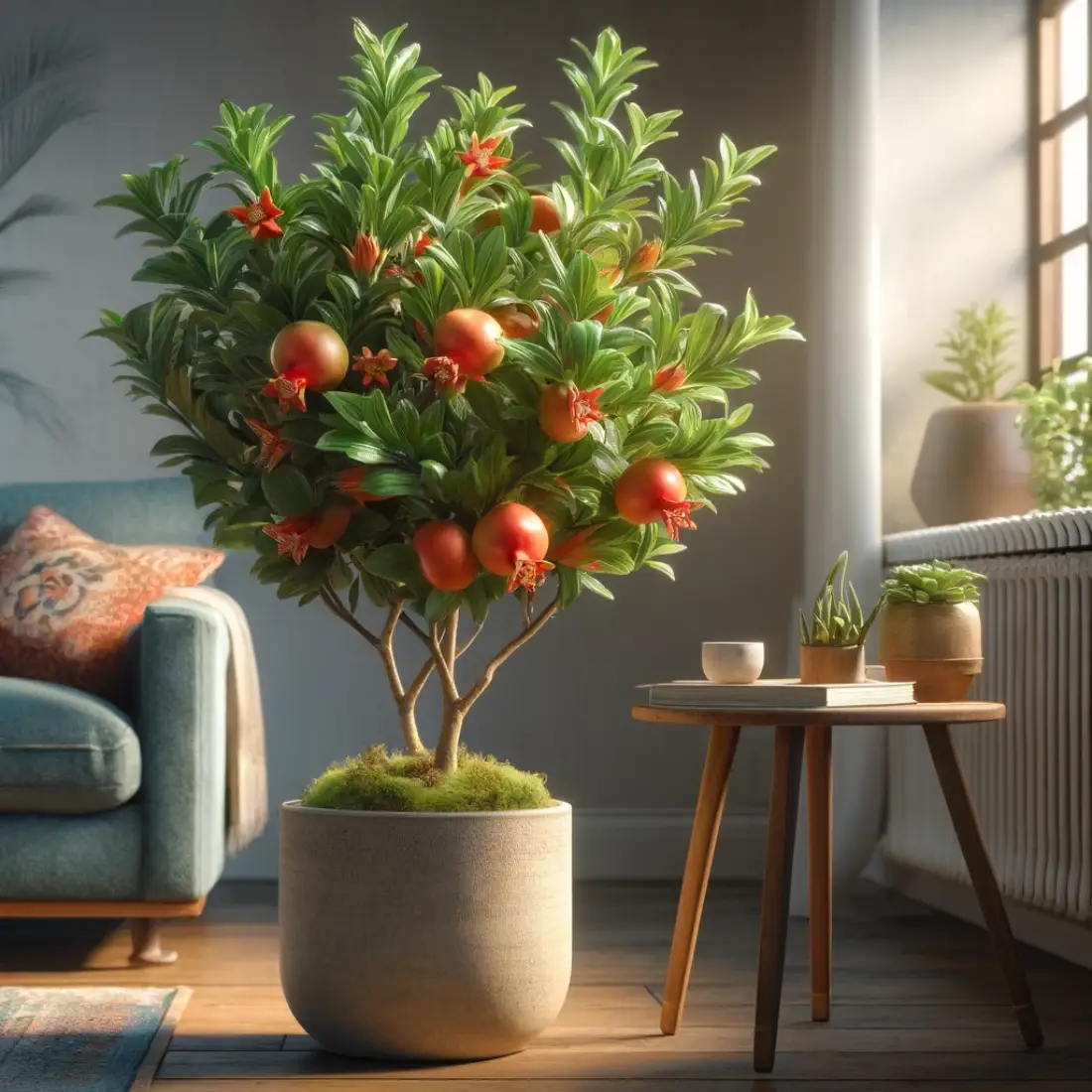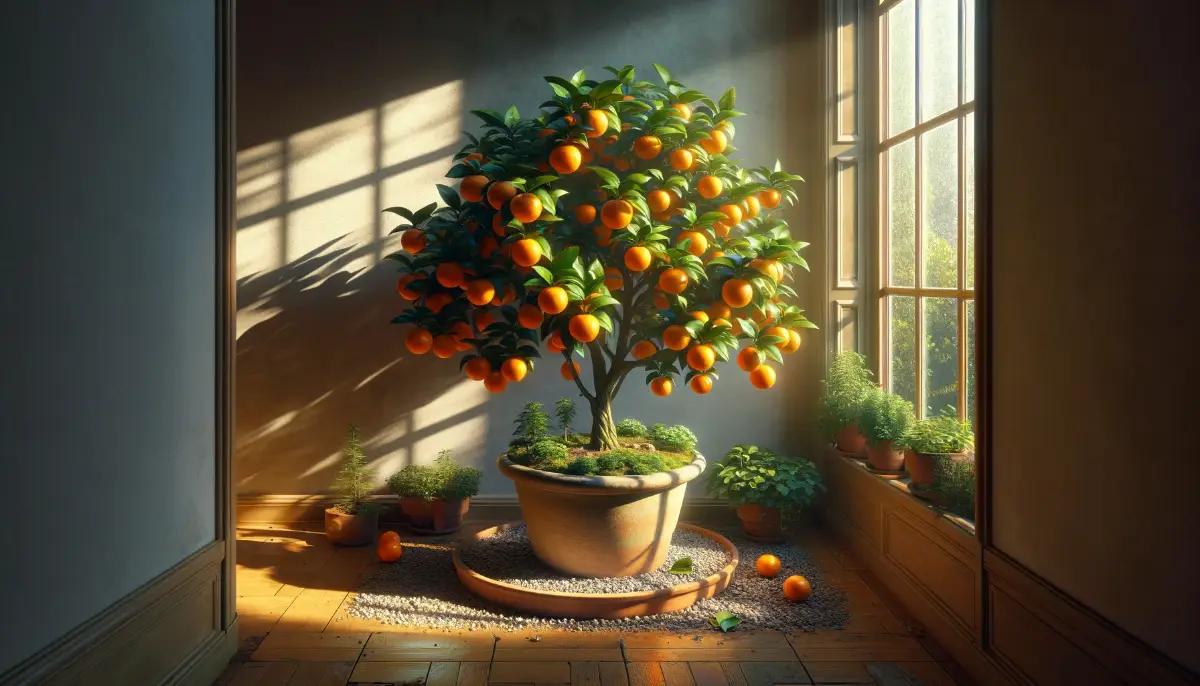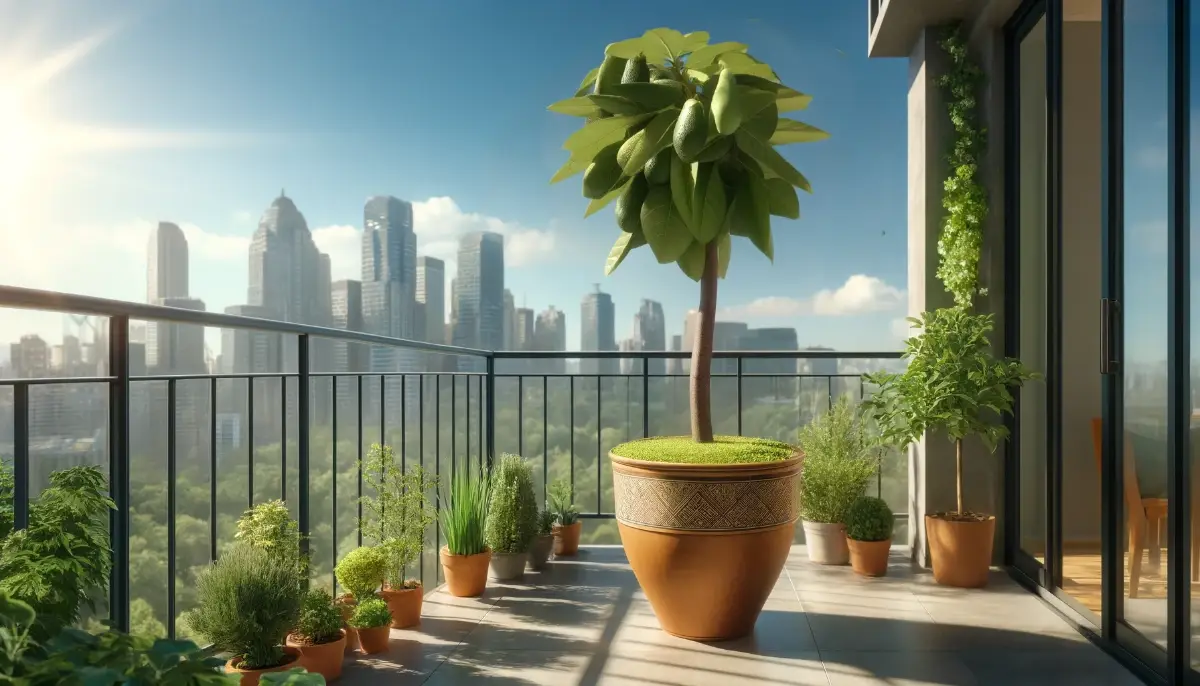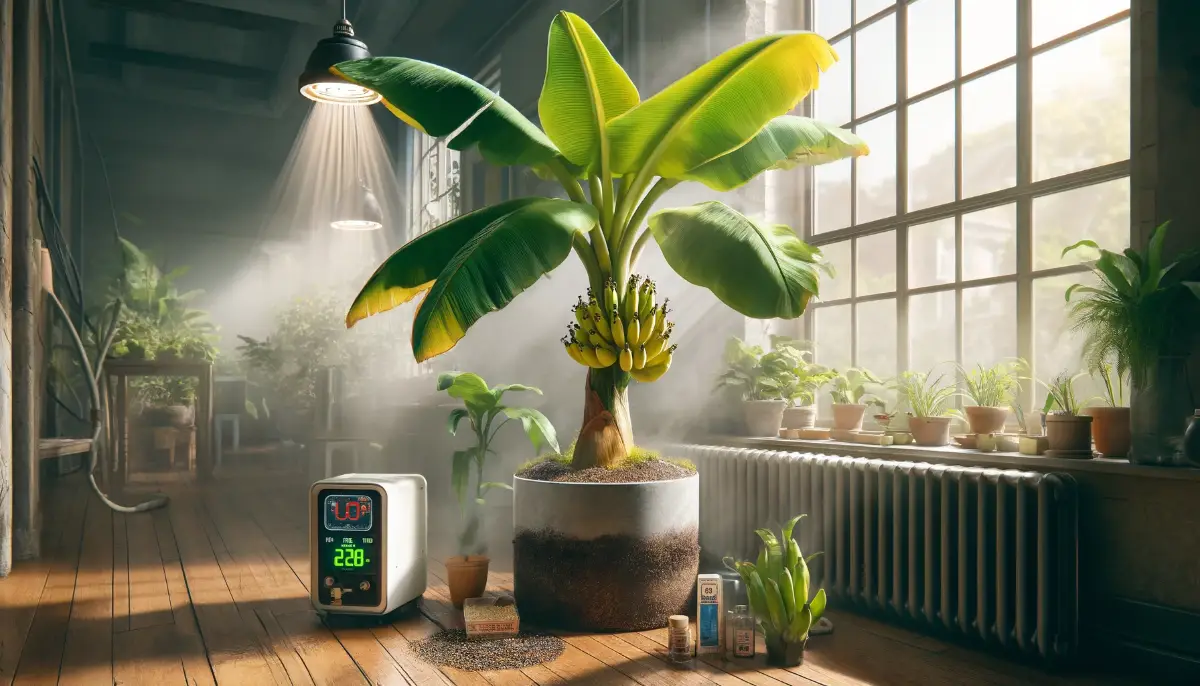The dwarf pomegranate (Punica granatum var. nana) is a compact variety of the traditional pomegranate plant, known for its ornamental beauty and the ability to produce small, yet edible fruits. This miniature version is ideal for indoor gardening due to its manageable size, typically reaching only 2 to 3 feet in height. It brings a touch of the exotic to indoor spaces with its glossy green leaves, vibrant orange-red flowers, and miniature pomegranates.
Growing a dwarf pomegranate indoors offers several benefits. Aside from its aesthetic appeal, the plant can purify the air and enhance indoor spaces with a splash of color and life. Additionally, cultivating an indoor pomegranate can be a rewarding experience for those interested in home gardening, even in small urban apartments.
Optimal Growing Conditions for Dwarf Pomegranate Indoors
Light Requirements
- Sunlight Exposure: Dwarf pomegranates need plenty of sunlight to thrive. They require at least 6 hours of direct sunlight each day. Place the plant near a south-facing window for optimal light exposure.
- Supplemental Lighting: If natural sunlight is insufficient, especially during winter months, use grow lights to provide the necessary light spectrum and duration.
Soil and Container
- Soil Type: Use well-draining soil with a slightly acidic to neutral pH (6.0-7.0). A good potting mix with added perlite or sand can improve drainage.
- Container: Choose a container with adequate drainage holes to prevent waterlogging. A pot size of 10-12 inches in diameter is suitable for a young plant, with the potential to repot as the plant grows.
Watering and Humidity
- Watering Frequency: Water the plant thoroughly but allow the top inch of soil to dry out between waterings. Overwatering can lead to root rot, while underwatering can stress the plant.
- Humidity Levels: Dwarf pomegranates prefer moderate humidity. If the indoor air is very dry, increase humidity around the plant using a humidifier or by placing a tray of water nearby.
Temperature and Climate Control
- Ideal Temperature Range: Maintain indoor temperatures between 60°F to 75°F (15°C to 24°C). Avoid exposing the plant to temperatures below 50°F (10°C).
- Climate Control: Ensure the plant is not exposed to sudden temperature changes, drafts, or heating vents. Consistency in temperature is key to preventing stress.
Planting the Dwarf Pomegranate
Selecting the Plant or Seeds
- Choosing Seeds or Plants: You can start with seeds or a young dwarf pomegranate plant. Seeds require more time and patience, while young plants offer a quicker start.
- Healthy Specimens: Ensure seeds are fresh and viable, or select young plants that are healthy, with no signs of disease or pests.
Preparing the Container
- Size and Material: Use a container that is at least 10-12 inches in diameter for young plants. As the plant grows, you may need to repot to a larger container.
- Drainage: Ensure the container has adequate drainage holes to prevent waterlogging and root rot.
Soil Preparation
- Soil Mix: Use well-draining soil, such as a mix of potting soil, perlite, and sand. The soil should be slightly acidic to neutral, with a pH of 6.0-7.0.
- Organic Matter: Incorporate organic matter, such as compost or worm castings, into the soil to provide essential nutrients and improve soil structure.
Planting Steps
Filling the Container: Fill the container with the prepared soil mix, leaving enough space at the top to plant the seeds or young plant.
Planting Seeds:
- Sowing Depth: Plant the seeds about 1/4 inch deep in the soil.
- Spacing: If planting multiple seeds, space them at least 6 inches apart to allow room for growth.
- Watering: Lightly water the soil to moisten it, but avoid making it soggy.
Planting Young Plants:
- Positioning: Dig a hole in the center of the container large enough to accommodate the root ball of the young plant.
- Planting: Place the plant in the hole, ensuring the root ball is covered with soil and the base of the plant is level with the soil surface.
- Watering: Water thoroughly to settle the soil around the roots.
Initial Care
- Watering: Keep the soil consistently moist but not waterlogged. Allow the top inch of soil to dry out between waterings.
- Light: Place the container in a location where the plant will receive at least 6 hours of direct sunlight daily. South-facing windows are ideal.
- Temperature: Maintain indoor temperatures between 60°F to 75°F (15°C to 24°C). Avoid exposure to drafts and sudden temperature changes.
Monitoring and Adjusting
- Growth Observation: Regularly check the plant for signs of new growth, which indicates successful establishment.
- Adjusting Care: Be prepared to adjust watering frequency, light exposure, and other care aspects based on the plant’s response and environmental conditions.
By carefully planting and providing the right initial care for your dwarf pomegranate, you set the foundation for a healthy and thriving plant that can be a delightful addition to your indoor garden.
Organic Feeding and Fertilizing Beneficial for Dwarf Pomegranate
Using organic methods for feeding and fertilizing your dwarf pomegranate can promote healthier growth, improve soil quality, and reduce the risk of chemical build-up. Here are some effective organic options:
Organic Fertilizers
- Compost: Rich in nutrients and beneficial microorganisms, compost improves soil structure and fertility. Incorporate compost into the soil mix before planting and top-dress the soil surface every few months.
- Worm Castings: Worm castings, or vermicompost, are a highly nutritious soil amendment. They enhance soil aeration and water retention while providing essential nutrients. Mix worm castings into the potting soil or apply as a top-dressing.
Organic Liquid Fertilizers
- Fish Emulsion: A natural source of nitrogen, fish emulsion supports leafy growth and overall plant health. Dilute fish emulsion according to the package instructions and apply every 3-4 weeks during the growing season.
- Seaweed Extract: Seaweed extract provides a balanced mix of macro and micronutrients, along with growth hormones that stimulate root development and stress resistance. Use as a foliar spray or soil drench every 4-6 weeks.
Manures and Animal By-products
- Aged Manure: Well-composted manure from cows, horses, or chickens can be an excellent source of nutrients. Ensure the manure is fully decomposed to avoid burning the plant roots. Mix into the potting soil or use as a mulch.
- Bone Meal: High in phosphorus, bone meal promotes strong root and flower development. Sprinkle a small amount around the base of the plant and water in well, typically once every few months.
Organic Mulches
- Leaf Mold: Decomposed leaves, or leaf mold, improve soil moisture retention and add organic matter. Use a mulch layer on top of the soil to maintain moisture and suppress weeds.
- Wood Chips or Bark: Organic wood chips or bark can be used as mulch to help retain soil moisture, regulate temperature, and gradually add organic matter as they decompose.
Homemade Fertilizer Teas
- Compost Tea: Brew compost tea by soaking compost in water for 24-48 hours, then strain and use the liquid to water your plants. This provides a quick nutrient boost and beneficial microbes.
- Banana Peel Tea: Rich in potassium, banana peel tea supports flowering and fruiting. Soak banana peels in water for a few days, then use the liquid to water your pomegranate.
Application Tips
- Timing: Apply organic fertilizers during the active growing season (spring and summer). Reduce or stop feeding during the plant’s dormant period (fall and winter).
- Quantity: Avoid over-fertilizing, as excess nutrients can harm the plant. Follow recommended application rates for each type of fertilizer.
- Integration: Combine different organic fertilizers to provide a balanced nutrient profile. Rotate applications to ensure the plant receives a variety of nutrients over time.
Pruning and Training Dwarf Pomegranate
Pruning and training are essential practices for maintaining the health, shape, and productivity of your indoor dwarf pomegranate.
Importance of Pruning and Training
- Health: Removing dead or diseased branches promotes overall plant health.
- Shape: Pruning helps maintain a desirable shape and size, especially important for indoor cultivation.
- Productivity: Proper pruning can enhance flowering and fruiting by directing the plant’s energy to productive growth.
Tools Needed
- Pruning Shears: Sharp, clean pruning shears are essential for making precise cuts without damaging the plant.
- Sterilizing Solution: Use alcohol or a bleach solution to sterilize your tools before and after use to prevent the spread of disease.
When to Prune
- Timing: The best time to prune dwarf pomegranate is in late winter or early spring before new growth begins. Light pruning can also be done throughout the growing season to maintain shape.
Pruning Techniques
Removing Dead or Diseased Wood:
- Identify and remove any branches that are dead, diseased, or damaged.
- Cut back to healthy wood, making clean cuts to prevent tearing.
Thinning:
- Thin out crowded branches to improve air circulation and light penetration.
- Focus on removing inward-growing branches that clutter the plant’s center.
Shaping:
- Maintain a balanced shape by selectively trimming back overgrown branches.
- Aim for a compact, bushy form that fits well in your indoor space.
Heading Cuts:
- Make heading cuts to encourage branching and bushier growth.
- Cut back to a bud or branch junction, about 1/4 inch above.
Size Control:
- Regularly prune to control the plant’s size, especially in small indoor spaces.
- Remove the tips of long branches to keep the plant compact.
Training Techniques
Supporting Growth:
- Use stakes or small trellises to support the plant if necessary.
- Tie branches loosely to support with soft ties, ensuring not to damage the stems.
Encouraging Desired Form:
- Train the plant to grow in a specific shape or direction by selective pruning and positioning.
- Regularly adjust ties and supports as the plant grows.
Pinching:
- Pinch back the tips of new growth to encourage bushier growth and more branching.
- This can be done throughout the growing season to maintain the plant’s shape.
Long-term Maintenance
- Regular Inspection: Regularly inspect your plant for signs of overgrowth, disease, or pest infestation.
- Consistent Pruning: Establish a routine pruning schedule to keep your plant healthy and well-shaped.
- Adjusting Techniques: Be prepared to adjust your pruning and training techniques based on the plant’s growth patterns and needs.
By incorporating these pruning and training techniques into your care routine, you can ensure your dwarf pomegranate remains healthy, attractive, and productive, enhancing the beauty and functionality of your indoor garden.
Pollination and Fruit Production for Dwarf Pomegranate
Ensuring successful pollination and fruit production in your indoor dwarf pomegranate requires understanding the plant’s reproductive processes and providing the right conditions.
Understanding Pollination
- Self-Pollinating: Dwarf pomegranates are generally self-pollinating, meaning they have both male (pollen) and female (ovule) parts within the same flower.
- Cross-Pollination: Although self-pollination is common, cross-pollination can increase fruit set and improve fruit quality. This can be achieved if multiple pomegranate plants are present.
Promoting Pollination Indoors
Natural Pollination:
- Air Movement: Ensure good air circulation around the plant to facilitate the transfer of pollen. Use fans if necessary.
- Insect Attraction: While indoor conditions limit natural pollinators, occasionally placing the plant outdoors (if possible and safe) can allow bees and other insects to assist in pollination.
Hand Pollination:
- Tools Needed: Use a small, soft paintbrush or cotton swab.
- Technique: Gently brush the inside of the flowers to transfer pollen from the stamens (male part) to the stigma (female part). Repeat this process for multiple flowers to increase chances of successful pollination.
Conditions for Fruit Production
Light: Ensure the plant receives at least 6 hours of direct sunlight daily or equivalent artificial lighting. Proper light exposure is crucial for flower and fruit development.
Temperature: Maintain indoor temperatures between 60°F to 75°F (15°C to 24°C). Consistent temperatures without drastic fluctuations are essential for healthy growth and fruiting.
Watering: Keep the soil consistently moist but not waterlogged. Water stress can affect flowering and fruit set.
Fertilizing: Use organic fertilizers rich in potassium and phosphorus to promote flowering and fruiting. Fish emulsion, compost tea, or banana peel tea are excellent choices. Fertilize every 2-4 weeks during the growing season, and reduce feeding during the dormant period.
Encouraging Fruit Set
Flower Care:
- Monitor the flowers regularly. Some natural flower drop is normal, but excessive drop can indicate issues with pollination or plant stress.
- Ensure the plant is not exposed to strong drafts or sudden temperature changes, which can cause flower drop.
Supporting Fruit Growth:
- Once fruit begins to set, continue to provide consistent care. Proper watering, feeding, and light are crucial.
- Thin out excessive fruits if necessary to allow remaining fruits to develop fully and avoid overburdening the plant.
Harvesting the Fruits
Maturity Indicators: Fruits are typically ready to harvest when they reach full color and emit a metallic sound when tapped. The skin may start to crack slightly when the fruit is fully ripe.
Harvesting Method: Use sharp, clean scissors or pruning shears to cut the fruit from the plant, leaving a small stem attached.
Post-Harvest Care:After harvesting, continue to care for the plant by maintaining proper watering and feeding schedules to prepare it for the next flowering and fruiting cycle.
Troubleshooting Common Problems with Dwarf Pomegranate
Indoor cultivation of dwarf pomegranate can present various challenges. Here’s a guide to identifying and addressing common issues to ensure a healthy and productive plant.
Yellowing Leaves
Causes:
- Overwatering: Root rot caused by waterlogged soil.
- Underwatering: Drought stress from insufficient watering.
- Nutrient Deficiency: Lack of essential nutrients, especially nitrogen.
Solutions:
- Adjust Watering: Ensure the soil is well-draining and water only when the top inch of soil is dry. Avoid letting the plant sit in water.
- Nutrient Boost: Fertilize with a balanced organic fertilizer. Incorporate compost or worm castings into the soil to provide necessary nutrients.
Lack of Flowering or Fruiting
Causes:
- Insufficient Light: Not enough direct sunlight or inadequate artificial lighting.
- Improper Feeding: Lack of nutrients, particularly phosphorus and potassium.
- Temperature Stress: Exposure to temperatures outside the ideal range.
Solutions:
- Increase Light Exposure: Ensure the plant receives at least 6 hours of direct sunlight or use full-spectrum grow lights.
- Fertilize Properly: Use fertilizers rich in phosphorus and potassium during the growing season to promote flowering and fruiting.
- Maintain Temperature: Keep indoor temperatures between 60°F to 75°F (15°C to 24°C). Avoid exposing the plant to drafts and sudden temperature changes.
Leaf Drop
Causes:
- Watering Issues: Overwatering or underwatering.
- Temperature Fluctuations: Sudden changes in temperature.
- Pest Infestation: Presence of pests like aphids or spider mites.
Solutions:
- Consistent Watering: Adjust your watering schedule to maintain even moisture levels.
- Stable Environment: Keep the plant away from drafts and maintain a consistent temperature.
- Pest Control: Inspect the plant regularly for pests. Use organic insecticidal soap or neem oil to treat infestations.
Pest Infestation
Common Pests: Aphids, spider mites, whiteflies, and scale insects.
Signs: Visible insects, sticky residue (honeydew), webbing, or distorted leaves.
Solutions:
- Manual Removal: Remove pests by hand or with a strong water spray.
- Insecticidal Soap: Apply organic insecticidal soap or neem oil to affected areas. Repeat as necessary.
- Preventative Measures: Keep the plant healthy and stress-free to reduce susceptibility to pests.
Root Rot
Causes: Overwatering leading to waterlogged soil and lack of oxygen to roots.
Solutions:
- Improving Drainage: Ensure the container has sufficient drainage holes. Use well-draining soil mixes.
- Watering Practices: Water only when the top inch of soil is dry. Avoid letting the plant sit in water.
- Treating Affected Plants: If root rot is suspected, remove the plant from the pot, trim off affected roots, and repot in fresh, well-draining soil.
Stunted Growth
Causes:
- Nutrient Deficiency: Lack of essential nutrients.
- Poor Light Conditions: Insufficient light exposure.
- Root-Bound: Plant outgrowing its container.
Solutions:
- Fertilizing: Apply a balanced organic fertilizer regularly during the growing season.
- Increasing Light: Ensure the plant receives adequate light, either through natural sunlight or grow lights.
- Repotting: If the plant is root-bound, repot it into a larger container with fresh soil.
Fruit Drop
Causes:
- Water Stress: Irregular watering practices.
- Nutrient Imbalance: Lack of potassium or other essential nutrients.
- Environmental Stress: Extreme temperature changes or insufficient light.
Solutions:
- Consistent Watering: Maintain even moisture levels, avoiding both drought and waterlogging.
- Balanced Fertilizing: Use fertilizers high in potassium to support fruit development.
- Stable Conditions: Provide consistent temperature and light exposure.
FAQs About Growing and Caring for Dwarf Pomegranate Indoors
How much sunlight does a dwarf pomegranate need when grown indoors?
Dwarf pomegranates require at least 6 hours of direct sunlight each day. Place them near a south-facing window for optimal light exposure. If natural light is insufficient, supplement with full-spectrum grow lights.
What type of soil is best for a dwarf pomegranate?
A well-draining soil mix is essential. Use a combination of potting soil, perlite, and sand. The soil should be slightly acidic to neutral, with a pH of 6.0-7.0. Incorporating organic matter like compost can also improve soil quality.
How often should I water my indoor dwarf pomegranate?
Water the plant thoroughly, allowing the top inch of soil to dry out between waterings. Avoid waterlogging, as this can lead to root rot. The frequency may vary depending on the indoor climate, but typically once a week is a good starting point.
What temperature range is ideal for a dwarf pomegranate indoors?
Maintain indoor temperatures between 60°F to 75°F (15°C to 24°C). Avoid exposing the plant to temperatures below 50°F (10°C) and protect it from sudden temperature changes and drafts.
How do I fertilize a dwarf pomegranate organically?
Use organic fertilizers such as compost, worm castings, fish emulsion, or seaweed extract. Fertilize every 2-4 weeks during the growing season (spring and summer). Reduce feeding during the dormant period (fall and winter).
When and how should I prune my dwarf pomegranate?
Prune in late winter or early spring before new growth begins. Remove dead, diseased, or crowded branches to improve air circulation and light penetration. Regular light pruning throughout the growing season can help maintain shape and size.
How do I ensure my dwarf pomegranate flowers and produce fruit indoors?
Ensure the plant receives sufficient light, water, and nutrients. Hand pollinate flowers using a small paintbrush or cotton swab to transfer pollen from the stamens to the stigma. Maintain stable temperatures and avoid environmental stress.
What are common pests, and how do I manage them organically?
Common pests include aphids, spider mites, whiteflies, and scale insects. Inspect the plant regularly and remove pests manually or use organic insecticidal soap or neem oil. Maintaining plant health reduces susceptibility to pests.
Why are my dwarf pomegranate’s leaves turning yellow?
Yellowing leaves can result from overwatering, underwatering, or nutrient deficiencies. Ensure proper watering practices and use a balanced organic fertilizer to address nutrient issues. Check for and address root rot if suspected.
Can I grow a dwarf pomegranate from seeds indoors?
Yes, you can start a dwarf pomegranate from seeds, though it requires more time and patience. Plant seeds about 1/4 inch deep in well-draining soil, keep the soil moist, and provide adequate light. Germination can take a few weeks to a few months.










